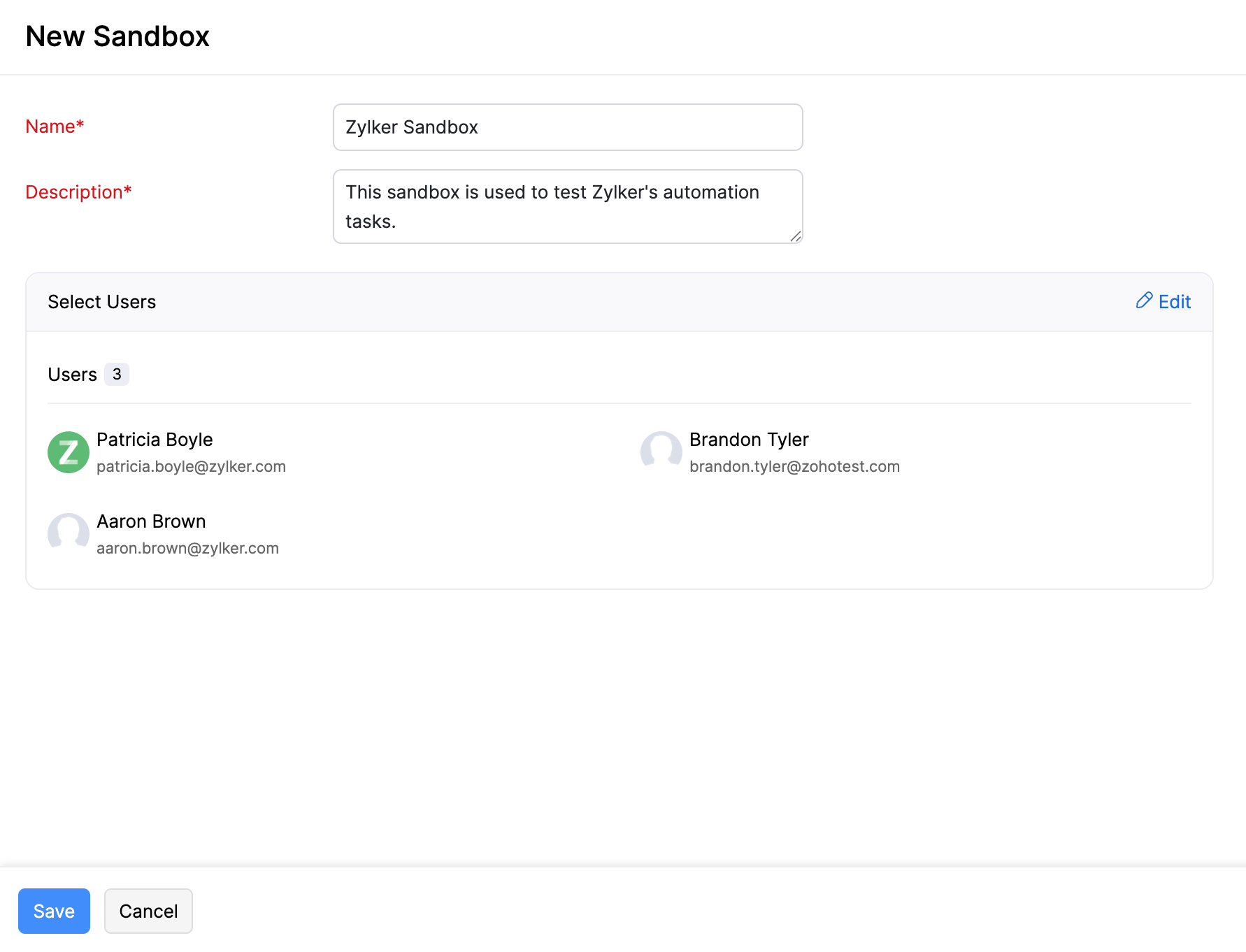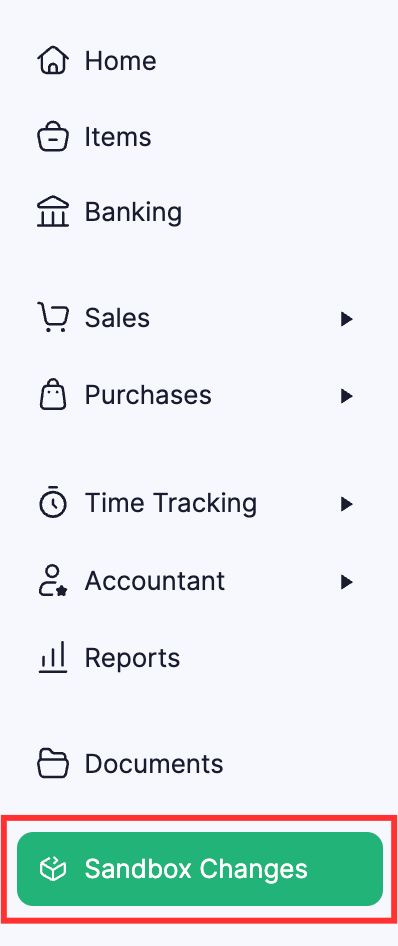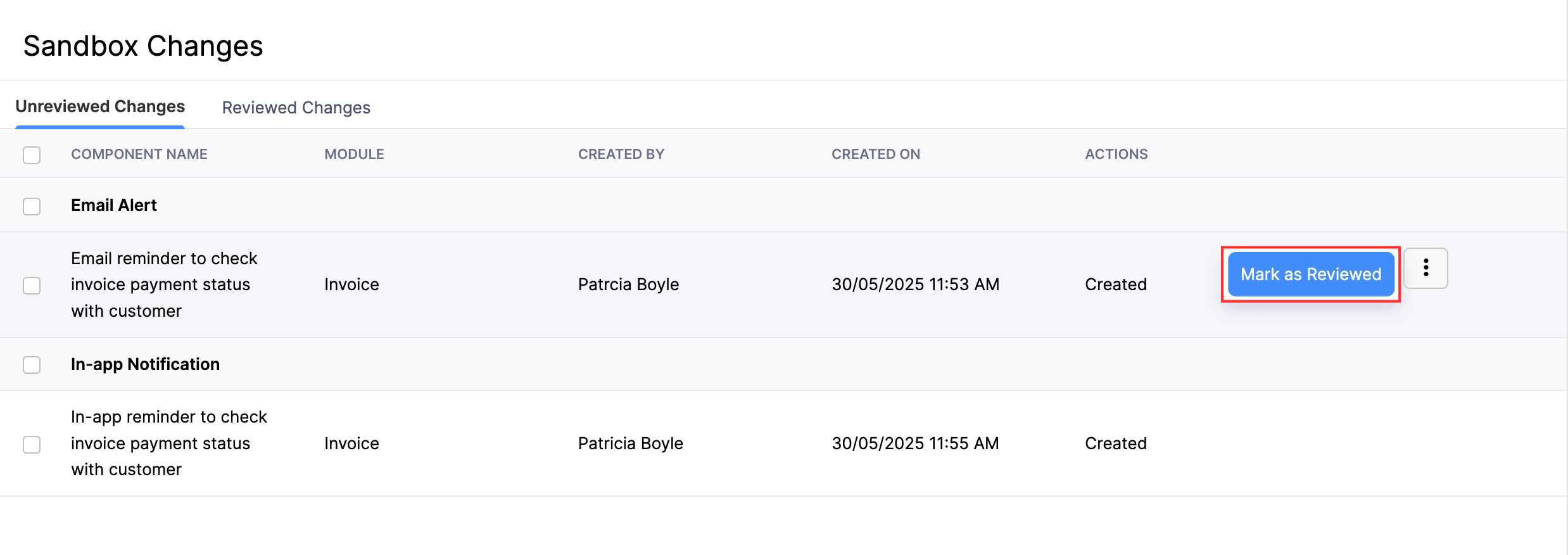Sandbox
A Sandbox is a separate environment where you can test and debug the features you develop for your Zoho Books organisation without affecting the organisation in real-time.
Once you create a sandbox, a new organisation with the sandbox name will be created. You can use this organisation to test features. Any changes you make here will not affect your production organisation until the changes are deployed. After testing and verifying that the changes are functioning properly, you can deploy them to the production organisation.
Scenario: Zylker is an online retail store that processes over 10,000 invoices daily. They used to manage their business processes manually before moving to Zoho Books.Patricia, Zylker’s CEO, wanted to use the automation capabilities of Zoho Books to streamline their operations. However, she was hesitant since they deal with large enterprises and even a small mistake could cost their business big losses. To address her concerns, Zylker’s developers suggested using the Sandbox feature in Zoho Books. This feature allows them to create an isolated environment where they can test their customisation and automation configurations safely without affecting their business operations.
Note:
- This feature is only available in certain plans of Zoho Books. Visit the pricing page to check if it’s available in your current plan.
- You can only create one sandbox per organisation. The sandbox organisation will be automatically deleted if it is inactive for 120 days.
Terms to Remember
Before you begin creating a sandbox, read the following terms and their definitions as they are key to understanding how the feature works.
- Production Organisation: It is the organisation that your users use to carry out their day-to-day business tasks.
- Sandbox Organisation: It is the organisation in which your users will test their changes.
- Components: The changes you make in the organisation are called components. You need to deploy them to the production organization once they are reviewed.
Create a Sandbox
To create a sandbox in your organisation:
- Go to Settings in the top right corner of the page.
- Click Sandbox under Developer & Data.
- Click + New Sandbox in the top right corner.
- Enter the sandbox’s Name and provide a Description.
- If you want the sandbox to be used only by specific users in your organisation, click Select Users. Then, select the users who can access the sandbox.
- Click Save.
A sandbox will be created. You can use it to test the features you’re building for your organisation.

Open a Sandbox
Here’s how you can open a sandbox:
- Go to Settings in the top right corner of the page.
- Click Sandbox under Developer & Data.
- In the Sandbox List tab, hover over the required sandbox and click Go to Sandbox. The sandbox organisation will open in a new tab.

Add a Component
The changes you make in the sandbox organisation are called components. Click the respective component mentioned below to learn how to create them in Zoho Books.
The following are the components supported in the sandbox organisation:
- Custom Fields
- Custom Buttons
- Related Lists
- Custom Modules
- Custom Views
- Connections
- Workflow Rules
- Workflow Actions (Email Alerts, In-app Notifications, Custom Functions, Field Updates, and Webhooks)
- Schedules
- Incoming Webhooks
- Web Tabs
- PDF Templates
- Signals
View Sandbox Changes
You can view all the changes made in the sandbox organisation in one place. To view the changes:
- Go to the sandbox organisation.
- Click Sandbox Changes on the left sidebar.

The components created in the sandbox organisation will be listed in the Unreviewed Changes tab. Once you’ve verified the changes, you can mark them as reviewed, and they’ll be moved to the Reviewed Changes tab. When you deploy them, they’ll be available in the production organisation for which the sandbox was created.
Mark a Component as Reviewed
When you create components in the sandbox organisation, they’ll be added to the Unreviewed Changes tab in Sandbox Changes.
Once you’ve tested them, you need to move them to the Reviewed Changes tab. Only reviewed components can be deployed to the production organisation.
To mark a component as reviewed:
- Go to the sandbox organisation.
- Click Sandbox Changes on the left sidebar.
- In the Unreviewed Components tab, hover over the component you want to mark as reviewed and click the More button.
- Select Mark as Reviewed from the dropdown.

Mark a Component as Unreviewed
If you accidentally marked a component as reviewed, you can undo it. Here’s how:
- Go to the sandbox organisation.
- Click Sandbox Changes on the left sidebar.
- In the Reviewed Components tab, hover over the component you want to mark as unreviewed and click the More button.
- Select Mark as Unreviewed from the dropdown.

Note: If the reviewed component has been deployed to your production organisation, you cannot mark it as unreviewed.
Deploy Components
Once you’ve marked components as reviewed in the sandbox organisation, you need to deploy the components to use them in the production organization. Here’s how:
- Go to the production organisation.
- Click Settings in the top right corner of the page.
- Click Sandbox under Developer & Data.
- Click the required sandbox in the Sandbox List tab.
- Go to the Changes tab.
- Select the components to be deployed and click Deploy Changes in the top right corner.

- Enter the Description and click Deploy Changes.
Deployment Conflicts
Let’s say you initially deployed a few components to your production organisation, but later deleted one of the components. The deleted component will still be available in the sandbox organisation. If you make changes to this component and redeploy it to your production organisation, it will cause a conflict. In such cases, the components with conflicts will not be deployed, while components without any conflicts will be deployed.
View Deployment Logs
You can view the logs of the changes deployed from a sandbox organisation. Here’s how:
- Go to the production organisation.
- Click Settings in the top right corner of the page.
- Click Sandbox under Developer & Data.
- In the Sandbox List tab, click the sandbox for which you want to view the logs.
- Click the Deployment Logs tab.
Logs of all changes deployed from the sandbox will be available here. You can also filter the logs based on actions (created, updated, and deleted), the users who deployed the changes, and the date range.

Other Actions for Production Organization
Edit a Sandbox
To edit a sandbox:
- Go to the production organisation.
- Click Settings in the top right corner of the page.
- Click Sandbox under Developer & Data.
- In the Sandbox List tab, hover over the sandbox for which you want to edit the details and click the More button.
- Select Edit from the dropdown.

- Make the necessary changes and click Save.
Rebuild a Sandbox
When you create a sandbox, it automatically populates the components from your production organisation into your sandbox organisation. If you add components to your production organisation after creating the sandbox, these components will not be available in the sandbox organisation. To add them, you can rebuild the sandbox.
Warning: Once you rebuild a sandbox, all unreviewed components will be deleted.
Here’s how you can rebuild a sandbox:
- Go to the production organisation.
- Click Settings in the top right corner of the page.
- Click Sandbox under Developer & Data.
- In the Sandbox List tab, click the sandbox that you want to rebuild.
- Click Rebuild Sandbox in the top right corner.

- Check I understand that rebuilding the sandbox will delete all the undeployed components.
- Click Rebuild.
Note: You can rebuild a sandbox once every 24 hours.
Mark a Sandbox as Inactive
If you no longer need a sandbox but you don’t want to delete it, you can mark it as inactive. Here’s how:
- Go to the production organisation.
- Click Settings in the top right corner of the page.
- Click Sandbox under Developer & Data.
- In the Sandbox List tab, hover over the sandbox that you want to mark as inactive and click the More button.
- Select Mark as Inactive from the dropdown.

Mark a Sandbox as Active
You can mark an inactive sandbox as active. Here’s how:
- Go to the production organisation.
- Click Settings in the top right corner of the page.
- Click Sandbox under Developer & Data.
- In the Sandbox List tab, hover over the inactive sandbox and click the More button.
- Select Mark as Active from the dropdown.

Delete a Sandbox
Here’s how you can delete a sandbox:
- Go to the production organisation.
- Click Settings in the top right corner of the page.
- Click Sandbox under Developer & Data.
- In the Sandbox List tab, hover over the sandbox you want to delete and click the More button.
- Select Delete from the dropdown.

- Click Confirm in the pop-up that appears.


 Yes
Yes